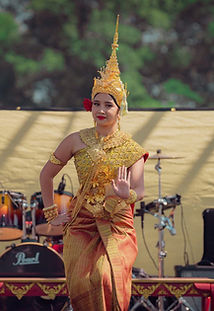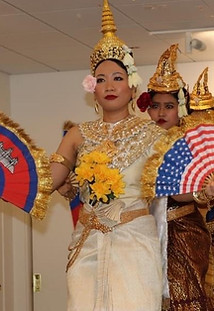
របាំ or Robam
Khmer Classical Dance (Robam Kbach Khmer Boran):
A Sacred Symphony of Movement
Khmer Classical Dance, known in Khmer as Robam Kbach Khmer Boran,
is one of Cambodia’s most treasured cultural expressions. Rooted in the royal
courts of the Angkorian era, this dance form is not merely performance—it
is ritual, storytelling, and spiritual homage woven into elegant motion. Often
referred to as the “royal ballet of Cambodia,” it embodies centuries of
tradition, mythology, and artistic discipline.
Origins and Spiritual Significance Originally performed by temple
dancers to honor the gods and entertain royalty, Khmer Classical Dance has
deep ties to Hindu and Buddhist cosmology. The dancers were considered
living offerings, and their movements were believed to connect the earthly
realm with the divine. This sacred lineage continues today, with performances often held during religious ceremonies, royal events, and cultural festivals.
Gesture as Language Unlike Western dance forms that rely on broad physicality, Khmer Classical Dance communicates through subtlety. Over 1,500 codified hand gestures and postures are used to express emotions, narrate legends, and depict characters. The dancer’s eyes, fingers, and feet are trained to move in harmony, creating a visual poetry that speaks without words.


Music and Costume The dance is accompanied by the Pinpeat orchestra, a traditional ensemble featuring gongs, xylophones, drums, and wind instruments. The music is cyclical and hypnotic, guiding the dancer’s rhythm and emotion. Costumes are inspired by ancient carvings found in Angkor Wat and also the scales of the Mother Naga, with shimmering textiles and symbolic motifs that reflect divine beauty and royal elegance.
Preservation and Revival During the Khmer Rouge regime, much of Cambodia’s artistic heritage was nearly lost. But thanks to the resilience of surviving artists and cultural institutions, Khmer Classical Dance has been revived and continues to flourish. It is now taught in schools, performed internationally, and recognized by UNESCO as an Intangible Cultural Heritage of Humanity.


